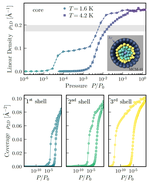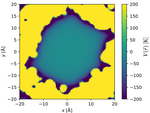Dimensional Reduction of Superfluid Helium
 Dimensional Reduction of Superfluid Helium A quasi-one-dimensional chain of helium atoms may be achieved through preplating nanoporous materials with rare gases.
Dimensional Reduction of Superfluid Helium A quasi-one-dimensional chain of helium atoms may be achieved through preplating nanoporous materials with rare gases.One dimensional quantum many body systems have been of long standing interest due to profound differences from their two- and three-dimensional counterparts. Tomonaga-Luttinger liquid (TLL) theory is expected to describe these systems at low energies but exhaustive testing has not been possible due to the difficulties in realizing good model systems with a tunable Luttinger interaction parameter. Helium in quasi-one-dimensional confinement presents an excellent platform to study the emergence of a TLL over a broad range of interaction strengths. In collaboration with an experimental group (P. Sokol (IU)) at the forefront of this field, a well-characterized platform for one-dimensional confinement of helium has been developed. The molecular sieve Mobil composition of matter No. 41 (MCM-41) preplated with a monolayer of argon gas offers enough constriction to prevent the formation of bulk fluid (with pores hundreds of nanometers long). Instead, concentric shells of helium form along the pore walls until a single channel of helium forms at the center. The formation of this structure is no coincidence as the MCM-41 pore diameter and preplating rare gas have been carefully chosen such that the ratio of the effective pore radius to the distance between shells (set by the helium interaction potential) is approaching an integer. Large scale quantum Monte Carlo simulations of the helium/MCM-41 system show tunability in the density of the central helium column. I will continue my work through further characterization the confinement environment by marrying grand canonical Monte Carlo molecular simulation software with classical molecular dynamics for a closer description of the interaction potential as well as through the development of new technologies (See Analytic Continuation Problem) to compare imaginary-time quantum Monte Carlo data with experimental measurements. Additional study is required to confirm TLL-like behavior.



